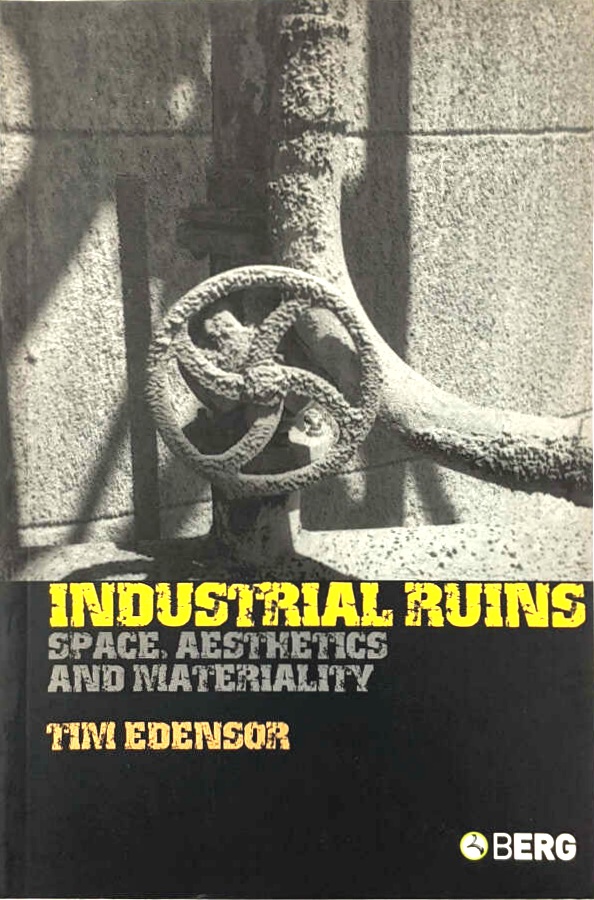![]() 'Industrial Ruins: Spaces, Aesthetics and Materiality', by T Edensor
'Industrial Ruins: Spaces, Aesthetics and Materiality', by T Edensor
208 pp, illustrated. Oxford and New York: Berg, 2005. ₤30.99 (paperback). ISBN 9781845200763

A BOOK WE MISSED
This book is too old to review; the following note will give some idea of what the book was about. Published 20 years ago, Industrial Ruins has been largely ignored by industrial archaeologists, yet there are passages in this volume which could have been written by many of us.
Industrial Ruins: Spaces, Aesthetics and Materiality deplores the significant fact that in cities, industrial ruins have been swept away and replaced with anonymous uniform blocks of buildings which have sterilised their area. The strong sense of place their locality previously exuded has been thoughtlessly swept away and the local terroir* has been dramatically dimmed. Although originally written with Manchester in mind it applies even more forcibly to London.
You don't need to look far in London to find examples of rebuilding which totally changes the character of a neighbourhood. Rectangular blocks are taking over the area of Aberfeldy Street and Fish Island, now with many standardised blocks, has lost its distinctive character. Major building works are now taking place at Hackney Wick.
The author writes that this book has evolved out of his enthusiasm for visiting industrial ruins, and spans three decades, primarily focusing on the traditional manufacturing areas of north and central England and Central Scotland. The ruins he has explored and which feature belong to Manchester, Stockport, Liverpool, Glossop, Stalybridge, Oldham, Blackburn, Burnley, Bolton, Birmingham, Stoke-on-Trent, Derby, Nottingham, Leicester, Grangemouth, Falkirk, Leith, Stranraer, Brynmawr, Luton, Southampton, Hull, Sheffield, Huddersfield, Newcastle, Sunderland and Hartlepool.
He has toured ruins which used to be crushing mills, motor factories, garages, goods yards and depots, locomotive works; boatyards and Chandlers, textile mills, tile factories and potbanks, chain manufacturers, foundries and steelworks, engineering workshops, rubber factories, dye producers and glass works, as well as numerous other indeterminate small workshops and warehouses.
One of the major objectives of the book is to contest the notion that ruins are spaces of waste, that contain nothing, or nothing of value, and that they are saturated with negativity as spaces of danger, delinquency, ugliness and disorder.
The following quotations give some idea of the flavour of parts of the book. Members of the recording group will be familiar with this:
-
Pigeons take advantage of the openings presented by shattered windows to build nests in attics and roost along shelves and beams, ledges akin to the cliffs they frequent elsewhere.
-
Fast-growing plants with intricate root systems which produce large numbers of seeds are able to germinate quickly. So a familiar sight of derelict spaces is the silken seeds of the rosebay willow herb, breeze-borne parachuting through the wasteland and beyond where the seeds will land and send out runners into any surrounding soil. Other, equally ubiquitous plants include buddleia which becomes especially noticeable when it attracts crowds of butterflies and bees in summer.
The author who is Professor of Social and Cultural Geography at the Institute of Place Management, Manchester Metropolitan University, has been described as a ruinologist but it is unclear which definition of ruinology the writer had in mind. No review of Industrial Ruins: Spaces, Aesthetics and Materiality seems ever to have appeared in an industrial archaeology periodical.
This book was written by an academic in his prime, aged 48. There may be parts of the book inappropriate for GLIAS readers but with this reservation Industrial Ruins: Spaces, Aesthetics and Materiality can be recommended. Bob Carr
-
* Terroir is a French term referring to the unique characteristics of a place, frequently used when discussing the production of wine or cheese. It is an intangible, which might also be applied to industrial locations.
![]() See also 'Palavras em Ruínas (Words in Ruins)', by Guilherme Pinheiro Pozzer.
See also 'Palavras em Ruínas (Words in Ruins)', by Guilherme Pinheiro Pozzer.